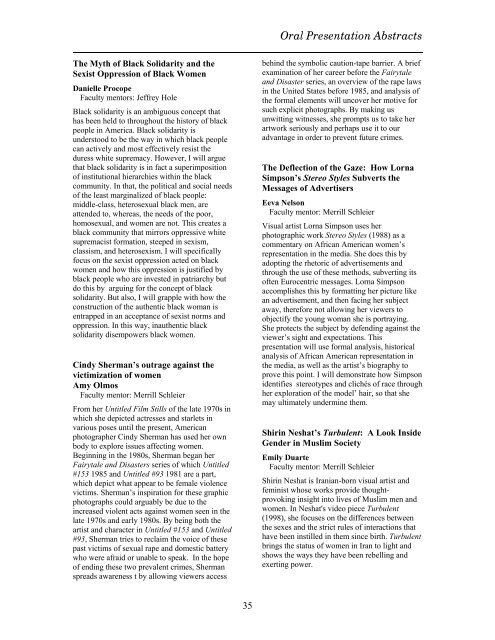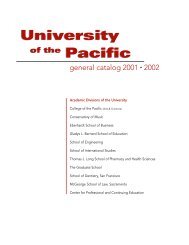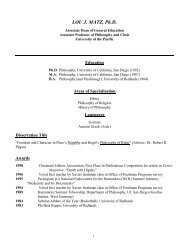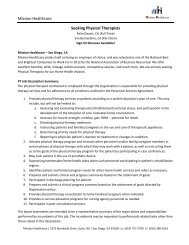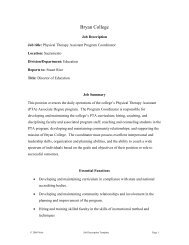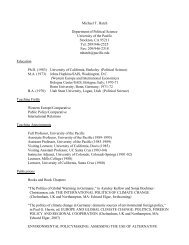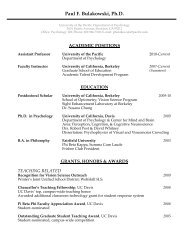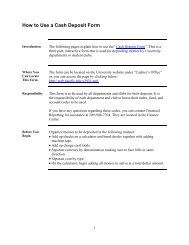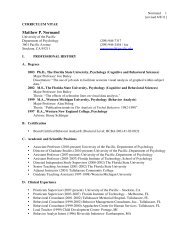purcc 2012 - University of the Pacific
purcc 2012 - University of the Pacific
purcc 2012 - University of the Pacific
You also want an ePaper? Increase the reach of your titles
YUMPU automatically turns print PDFs into web optimized ePapers that Google loves.
Oral Presentation Abstracts<br />
The Myth <strong>of</strong> Black Solidarity and <strong>the</strong><br />
Sexist Oppression <strong>of</strong> Black Women<br />
Danielle Procope<br />
Faculty mentors: Jeffrey Hole<br />
Black solidarity is an ambiguous concept that<br />
has been held to throughout <strong>the</strong> history <strong>of</strong> black<br />
people in America. Black solidarity is<br />
understood to be <strong>the</strong> way in which black people<br />
can actively and most effectively resist <strong>the</strong><br />
duress white supremacy. However, I will argue<br />
that black solidarity is in fact a superimposition<br />
<strong>of</strong> institutional hierarchies within <strong>the</strong> black<br />
community. In that, <strong>the</strong> political and social needs<br />
<strong>of</strong> <strong>the</strong> least marginalized <strong>of</strong> black people:<br />
middle-class, heterosexual black men, are<br />
attended to, whereas, <strong>the</strong> needs <strong>of</strong> <strong>the</strong> poor,<br />
homosexual, and women are not. This creates a<br />
black community that mirrors oppressive white<br />
supremacist formation, steeped in sexism,<br />
classism, and heterosexism. I will specifically<br />
focus on <strong>the</strong> sexist oppression acted on black<br />
women and how this oppression is justified by<br />
black people who are invested in patriarchy but<br />
do this by arguing for <strong>the</strong> concept <strong>of</strong> black<br />
solidarity. But also, I will grapple with how <strong>the</strong><br />
construction <strong>of</strong> <strong>the</strong> au<strong>the</strong>ntic black woman is<br />
entrapped in an acceptance <strong>of</strong> sexist norms and<br />
oppression. In this way, inau<strong>the</strong>ntic black<br />
solidarity disempowers black women.<br />
Cindy Sherman’s outrage against <strong>the</strong><br />
victimization <strong>of</strong> women<br />
Amy Olmos<br />
Faculty mentor: Merrill Schleier<br />
From her Untitled Film Stills <strong>of</strong> <strong>the</strong> late 1970s in<br />
which she depicted actresses and starlets in<br />
various poses until <strong>the</strong> present, American<br />
photographer Cindy Sherman has used her own<br />
body to explore issues affecting women.<br />
Beginning in <strong>the</strong> 1980s, Sherman began her<br />
Fairytale and Disasters series <strong>of</strong> which Untitled<br />
#153 1985 and Untitled #93 1981 are a part,<br />
which depict what appear to be female violence<br />
victims. Sherman’s inspiration for <strong>the</strong>se graphic<br />
photographs could arguably be due to <strong>the</strong><br />
increased violent acts against women seen in <strong>the</strong><br />
late 1970s and early 1980s. By being both <strong>the</strong><br />
artist and character in Untitled #153 and Untitled<br />
#93, Sherman tries to reclaim <strong>the</strong> voice <strong>of</strong> <strong>the</strong>se<br />
past victims <strong>of</strong> sexual rape and domestic battery<br />
who were afraid or unable to speak. In <strong>the</strong> hope<br />
<strong>of</strong> ending <strong>the</strong>se two prevalent crimes, Sherman<br />
spreads awareness t by allowing viewers access<br />
behind <strong>the</strong> symbolic caution-tape barrier. A brief<br />
examination <strong>of</strong> her career before <strong>the</strong> Fairytale<br />
and Disaster series, an overview <strong>of</strong> <strong>the</strong> rape laws<br />
in <strong>the</strong> United States before 1985, and analysis <strong>of</strong><br />
<strong>the</strong> formal elements will uncover her motive for<br />
such explicit photographs. By making us<br />
unwitting witnesses, she prompts us to take her<br />
artwork seriously and perhaps use it to our<br />
advantage in order to prevent future crimes.<br />
The Deflection <strong>of</strong> <strong>the</strong> Gaze: How Lorna<br />
Simpson’s Stereo Styles Subverts <strong>the</strong><br />
Messages <strong>of</strong> Advertisers<br />
Eeva Nelson<br />
Faculty mentor: Merrill Schleier<br />
Visual artist Lorna Simpson uses her<br />
photographic work Stereo Styles (1988) as a<br />
commentary on African American women’s<br />
representation in <strong>the</strong> media. She does this by<br />
adopting <strong>the</strong> rhetoric <strong>of</strong> advertisements and<br />
through <strong>the</strong> use <strong>of</strong> <strong>the</strong>se methods, subverting its<br />
<strong>of</strong>ten Eurocentric messages. Lorna Simpson<br />
accomplishes this by formatting her picture like<br />
an advertisement, and <strong>the</strong>n facing her subject<br />
away, <strong>the</strong>refore not allowing her viewers to<br />
objectify <strong>the</strong> young woman she is portraying.<br />
She protects <strong>the</strong> subject by defending against <strong>the</strong><br />
viewer’s sight and expectations. This<br />
presentation will use formal analysis, historical<br />
analysis <strong>of</strong> African American representation in<br />
<strong>the</strong> media, as well as <strong>the</strong> artist’s biography to<br />
prove this point. I will demonstrate how Simpson<br />
identifies stereotypes and clichés <strong>of</strong> race through<br />
her exploration <strong>of</strong> <strong>the</strong> model’ hair, so that she<br />
may ultimately undermine <strong>the</strong>m.<br />
Shirin Neshat’s Turbulent: A Look Inside<br />
Gender in Muslim Society<br />
Emily Duarte<br />
Faculty mentor: Merrill Schleier<br />
Shirin Neshat is Iranian-born visual artist and<br />
feminist whose works provide thoughtprovoking<br />
insight into lives <strong>of</strong> Muslim men and<br />
women. In Neshat's video piece Turbulent<br />
(1998), she focuses on <strong>the</strong> differences between<br />
<strong>the</strong> sexes and <strong>the</strong> strict rules <strong>of</strong> interactions that<br />
have been instilled in <strong>the</strong>m since birth. Turbulent<br />
brings <strong>the</strong> status <strong>of</strong> women in Iran to light and<br />
shows <strong>the</strong> ways <strong>the</strong>y have been rebelling and<br />
exerting power.<br />
35


